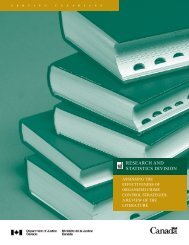National Threat Assessment 2008. Organised Crime - Politie
National Threat Assessment 2008. Organised Crime - Politie
National Threat Assessment 2008. Organised Crime - Politie
You also want an ePaper? Increase the reach of your titles
YUMPU automatically turns print PDFs into web optimized ePapers that Google loves.
make contact with one another. By disclosing personal information, police<br />
officers make themselves vulnerable for corruption.<br />
As a counterpoint to the risk factors stated, the increased emphasis on integrity<br />
should also be mentioned. In recent years more attention has been paid to<br />
corruption, which is reflected in more laws and regulations, for example, as<br />
well as in the development of integrity policy by government and businesses.<br />
According to some commentators, a lot can be achieved by supervising public<br />
servants in this area. They also indicate that the ‘selection, remuneration and<br />
training’ model should be applied in order to reduce integrity risks because<br />
these three issues are seen as key in the fight against corruption.<br />
It is not easy to know what to expect in the development of the corruption<br />
of public servants. Not enough figures are available to detect a trend and<br />
the crime-related factors are also ambiguous.<br />
However, criminals will be just as interested in (criminal investigation)<br />
information in the coming years, so it can be expected that attempts to bribe<br />
public servants will still be discovered in future.<br />
Conclusion<br />
The general opinion is that corruption of public servants is relatively rare<br />
in the Netherlands. There does not appear to be a direct need for criminal<br />
organisations to bribe public servants on a large scale. This does not mean<br />
that the consequences of corruption should not be taken seriously, even if the<br />
number of cases is small. The level of interest that criminal organisations have<br />
in obtaining inside information will not diminish. As a result, the integrity<br />
of the state under the rule of law runs the risk of being seriously damaged.<br />
Furthermore, due to increased and improved (technical) security, the key<br />
to information is held by individuals more and more frequently; they have<br />
passwords and the required biometric data. As a result, individuals are becoming<br />
increasingly vulnerable. It is possible that this will result in more cases of<br />
corruption or corruption attempts.<br />
This is sufficient reason to designate corruption of public servants as a threat<br />
for the next four years.<br />
5.2.3 Corruption in the business community<br />
Introduction and scope<br />
Corruption in the business community was not studied separately for this<br />
NTA. However, the various reports on which this NTA is based frequently<br />
report this phenomenon. That is why we will discuss it separately in this<br />
184 <strong>National</strong> <strong>Threat</strong> <strong>Assessment</strong> 2008 – <strong>Organised</strong> crime








